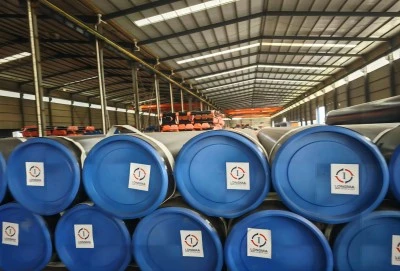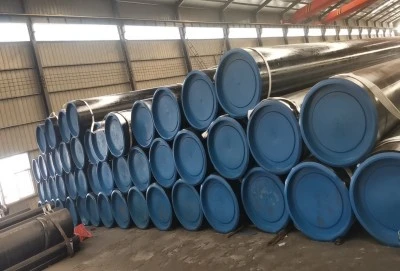In the oil and gas industry, ensuring the safety and integrity of pipelines is paramount. The API 5L X52 PSL2 pipes are widely used in oil transportation due to their superior strength, durability, and corrosion resistance. However, to maintain the highest levels of safety, it's crucial to adhere to stringent assessment standards. This article delves into the safety assessment standards for API 5L X52 PSL2 pipelines in oil transportation, exploring key parameters, risk assessment methodologies, and applicable international standards.
|
|
|
What are the key parameters in the safety evaluation of API 5L X52 PSL2 pipelines?
When evaluating the safety of API 5L X52 PSL2 pipes in oil transportation, several key parameters must be considered. These parameters help ensure the pipeline's integrity, longevity, and overall performance in demanding environments.
1. Material Properties
The material properties of API 5L X52 PSL2 pipes play a crucial role in their safety assessment. These properties include:
- Yield strength
- Tensile strength
- Elongation
- Charpy V-notch impact toughness
These properties determine the pipe's ability to withstand internal pressure, external loads, and environmental stressors. Regular testing and verification of these properties are essential to ensure the pipeline's continued safety and reliability.
2. Wall Thickness
The wall thickness of API 5L X52 PSL2 pipes is a critical parameter in safety assessment. It directly affects the pipe's pressure-bearing capacity and resistance to external damage. Factors influencing wall thickness calculations include:
- Design pressure
- Pipe diameter
- Material grade
- Safety factors
Regular inspection and monitoring of wall thickness are necessary to detect any potential thinning due to corrosion or erosion.
3. Corrosion Resistance
Corrosion is a significant concern in oil transportation pipelines. The corrosion resistance of API 5L X52 PSL2 pipes is evaluated based on:
- Internal corrosion rate
- External corrosion rate
- Effectiveness of corrosion protection systems (e.g., coatings, cathodic protection)
Regular monitoring and assessment of corrosion rates help predict the pipeline's remaining life and schedule maintenance activities accordingly.
4. Weld Quality
Welds are often considered the weakest points in a pipeline system. The safety assessment of API 5L X52 PSL2 pipelines includes thorough evaluation of weld quality, focusing on:
- Weld strength
- Weld defects
- Heat-affected zone properties
Non-destructive testing methods such as radiographic testing, ultrasonic testing, and magnetic particle inspection are commonly used to assess weld quality.
5. Operational Parameters
The operational parameters of the pipeline system significantly impact its safety. Key factors include:
- Operating pressure
- Flow rate
- Temperature fluctuations
- Pressure surges
Continuous monitoring and control of these parameters are essential to prevent overpressure situations and ensure safe operation within design limits.
How to assess the risk of failure in API 5L X52 PSL2 pipelines?
Assessing the risk of failure in API 5L X52 PSL2 pipes is a complex process that involves both quantitative and qualitative methods. A comprehensive risk assessment helps identify potential hazards, evaluate their consequences, and implement appropriate mitigation measures.
1. Hazard Identification
The first step in risk assessment is identifying potential hazards that could lead to pipeline failure. Common hazards for API 5L X52 PSL2 pipelines include:
- Internal and external corrosion
- Material defects
- Third-party damage
- Ground movement
- Operational errors
Hazard identification typically involves reviewing historical data, conducting field surveys, and consulting with industry experts.
2. Consequence Analysis
Once hazards are identified, the next step is to analyze the potential consequences of a pipeline failure. This analysis considers factors such as:
- Environmental impact
- Safety implications for nearby populations
- Economic losses
- Reputational damage
Advanced modeling techniques, such as computational fluid dynamics, are often used to simulate spill scenarios and assess their potential impact.
3. Probability Assessment
Estimating the probability of failure for API 5L X52 PSL2 pipelines involves analyzing various factors, including:
- Historical failure data
- Inspection results
- Operating conditions
- Environmental factors
Statistical methods, such as Bayesian analysis and Monte Carlo simulations, are commonly used to quantify failure probabilities.
4. Risk Evaluation
Risk evaluation involves combining the results of consequence analysis and probability assessment to determine the overall risk level. This is typically expressed as a risk matrix or risk index, allowing for prioritization of risk mitigation efforts.
5. Integrity Management Programs
Based on the risk assessment results, integrity management programs are developed to mitigate identified risks. These programs may include:
- Regular inspections and monitoring
- Preventive maintenance activities
- Corrosion control measures
- Emergency response planning
Continuous improvement of these programs is essential to ensure the ongoing safety and reliability of API 5L X52 PSL2 pipelines.
What international standards apply to the safety of API 5L X52 PSL2 pipelines in oil transport?
The safety of API 5L X52 PSL2 pipes in oil transportation is governed by various international standards and regulations. These standards provide guidelines for design, construction, operation, and maintenance of pipelines to ensure their safety and integrity.
1. API Standards
The American Petroleum Institute (API) has developed several standards applicable to API 5L X52 PSL2 pipelines:
- API 5L: Specification for Line Pipe
- API 1104: Welding of Pipelines and Related Facilities
- API 1160: Managing System Integrity for Hazardous Liquid Pipelines
These standards provide detailed requirements for pipe manufacturing, welding procedures, and integrity management practices.
2. ASME Standards
The American Society of Mechanical Engineers (ASME) has developed standards that are widely used in the pipeline industry:
- ASME B31.4: Pipeline Transportation Systems for Liquids and Slurries
- ASME B31G: Manual for Determining the Remaining Strength of Corroded Pipelines
These standards provide guidelines for pipeline design, construction, operation, and maintenance, as well as methods for assessing the integrity of corroded pipelines.
3. ISO Standards
The International Organization for Standardization (ISO) has developed several standards relevant to pipeline safety:
- ISO 3183: Petroleum and natural gas industries — Steel pipe for pipeline transportation systems
- ISO 13623: Petroleum and natural gas industries — Pipeline transportation systems
These standards provide international guidelines for pipeline materials, design, and operation.
4. NACE Standards
The National Association of Corrosion Engineers (NACE) has developed standards specifically addressing corrosion issues in pipelines:
- NACE SP0169: Control of External Corrosion on Underground or Submerged Metallic Piping Systems
- NACE SP0204: Stress Corrosion Cracking (SCC) Direct Assessment Methodology
These standards provide guidance on corrosion control and assessment methods, which are crucial for maintaining the integrity of API 5L X52 PSL2 pipelines.
5. Regional and National Standards
In addition to international standards, various regional and national standards apply to pipeline safety. For example:
- In the United States: CFR Title 49 Part 195 - Transportation of Hazardous Liquids by Pipeline
- In Europe: EN 14161 - Petroleum and natural gas industries. Pipeline transportation systems
These standards often incorporate or reference international standards while adding specific requirements for their respective jurisdictions.
Adherence to these international standards is crucial for ensuring the safety and reliability of API 5L X52 PSL2 pipelines in oil transportation. Companies operating these pipelines must stay updated with the latest revisions of these standards and implement them in their safety management systems.
In conclusion, the safety assessment of API 5L X52 PSL2 pipelines in oil transportation is a multifaceted process that requires consideration of various parameters, comprehensive risk assessment, and adherence to international standards. By implementing robust safety assessment practices and continuously improving integrity management programs, pipeline operators can ensure the safe and reliable transportation of oil, minimizing risks to people, the environment, and assets.
If you're looking for high-quality API 5L X52 PSL2 pipes that meet the stringent safety standards discussed in this article, look no further than Longma Group. Our pipes are manufactured to the highest quality standards, ensuring optimal performance and safety in oil transportation applications. Contact us today at info@longma-group.com to learn more about our products and how we can support your pipeline projects.














